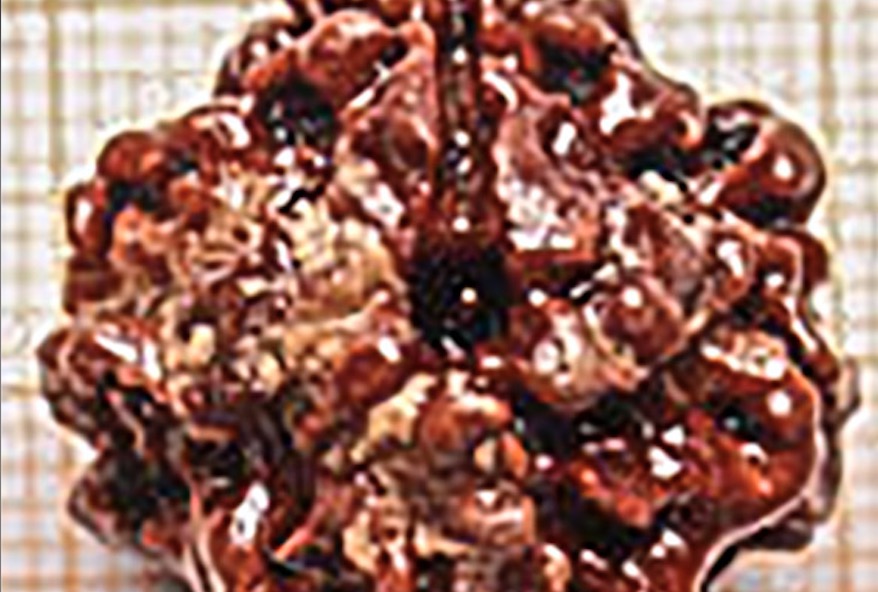PHOTO: HINDUISM TODAY
Genuine or forged?: An eight-faced rudraksha certified as real by IGL
CULTURE
HOW COMMON ARE FAKE RUDRAKSHAS?
______________________
Addressing concerns about Hinduism’s most celebrated prayer bead
______________________
HINDUISM TODAY’S CORRESPONDENT Rajiv Malik recently went on a short venture to collect rudrakshas from an array of local vendors in order to have them tested for authenticity. He purchased rudrakshas from various puja shops west of New Delhi and more from shops in Varanasi. For rudrakshas with fewer faces Rajiv paid around US$15, and more for those with higher face counts, for example $52 for a 11-faced rudraksha. He selected 19 beads of various face counts and qualities and brought them to the Indraprastha Gemological Laboratory (IGL) in New Delhi for testing. IGL tests not only rudrakshas, but diamonds and other gems as well.
The rudraksha (Elaeocarpus ganitrus) has long been held sacred throughout India. The term is variously translated as “Siva’s teardrops,” or “Eye of Rudra [Siva]” and refers to the third eye. According to legend, rudrakshas are Siva’s teardrops which fell to the Earth as He witnessed humanity’s self-created suffering. In another, they are tears of joy that He wept while emerging from meditation. The seeds thus represent the Lord’s compassionate blessings.
A rudraksha has segments, like those of a walnut or an orange, called faces. Most have five faces, neatly corresponding to Siva’s five powers of creation, preservation, dissolution, concealing grace and revealing grace. Those with more or fewer faces are rarer and hence more expensive. Being so common, a standard five-faced rudraksha costs very little. But beads with rare configurations, such 21 or more faces, can sell for thousands of dollars. Vendors abound, and unfortunately not every rudraksha sold is authentic. But the problem of fake beads is not as extensive as we had been led to believe.
Of the 19 seeds that we purchased and tested had tested at IGL, not a single one was flagged as fake. These included from three single-faced seeds, to one each of 2-faced to 11-faced seeds. This is good news for the average rudraksha purchaser, as it is at least anecdotal evidence that fake rudrakshas are less than common. We should note, however, that we did not test the most expensive seeds. Anyone seeking to spend thousands of dollars on a seed with a high face count, especially online, should consider buying only certified specimens.
When it comes down to it, faking seeds is not that easy. One method is to alter the apparent number of faces by carving additional lines into a regular rudraksha, creating more faces, or filling in lines to create fewer faces. Some fakes are carved from different woods or even plaster, and fakes with many faces—such as 21 or more—may be carved from betel nuts. This would likely not be economical but for the rarest forms.
We learned of various tests determining authenticity. The most infallible is to cut the seed open, but that destroys your rudraksha. Another common suggestion is the water test: It is thought that the average real rudraksha will sink, while other woods used in replicas will float. But is not always the case. A rudraksha picked while immature may rise to the surface. And apparently some rudraksha forgers add lead their beads.
A third test rumored to work is the copper coin test. The idea is that when a real rudraksha is placed between two copper coins or plates, the seed will rotate, or rotate in a certain direction. However when most any rounded object is put between two coins, it will at least move. Thus, there is little science to this test
There are two reliable nondestructive techniques which IGL uses. The first is to examine the seed with a microscope, watching for alterations, such as glue or carving strokes. The second is to x-ray the seed. Each segment of a rudraksha contains a seed compartment. If the number of seed compartments shown by x-ray does not match the number of outward faces, it’s likely there has been tampering. If there are no compartments at all, then it is a complete fake.
PHOTOS: RUDRA CENTER
A faked single-face rudraksha
PHOTOS: RUDRA CENTER
An x-ray reveals that the forged rudraksha has five seed compartments
